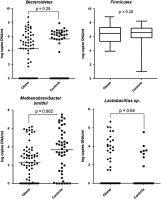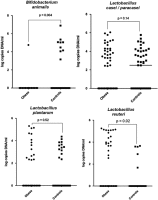Obesity-associated gut microbiota is enriched in Lactobacillus reuteri and depleted in Bifidobacterium animalis and Methanobrevibacter smithii - PubMed (original) (raw)
Multicenter Study
doi: 10.1038/ijo.2011.153. Epub 2011 Aug 9.
Affiliations
- PMID: 21829158
- PMCID: PMC3374072
- DOI: 10.1038/ijo.2011.153
Free PMC article
Multicenter Study
Obesity-associated gut microbiota is enriched in Lactobacillus reuteri and depleted in Bifidobacterium animalis and Methanobrevibacter smithii
M Million et al. Int J Obes (Lond). 2012 Jun.
Free PMC article
Retraction in
- Retraction Note: Obesity-associated gut microbiota is enriched in Lactobacillus reuteri and depleted in Bifidobacterium animalis and Methanobrevibacter smithii.
Million M, Maraninchi M, Henry M, Armougom F, Richet H, Carrieri P, Valero R, Raccah D, Vialettes B, Raoult D. Million M, et al. Int J Obes (Lond). 2024 Oct;48(10):1516. doi: 10.1038/s41366-024-01595-3. Int J Obes (Lond). 2024. PMID: 39075172 No abstract available.
Abstract
Background: Obesity is associated with increased health risk and has been associated with alterations in bacterial gut microbiota, with mainly a reduction in Bacteroidetes, but few data exist at the genus and species level. It has been reported that the Lactobacillus and Bifidobacterium genus representatives may have a critical role in weight regulation as an anti-obesity effect in experimental models and humans, or as a growth-promoter effect in agriculture depending on the strains.
Objectives and methods: To confirm reported gut alterations and test whether Lactobacillus or Bifidobacterium species found in the human gut are associated with obesity or lean status, we analyzed the stools of 68 obese and 47 controls targeting Firmicutes, Bacteroidetes, Methanobrevibacter smithii, Lactococcus lactis, Bifidobacterium animalis and seven species of Lactobacillus by quantitative PCR (qPCR) and culture on a Lactobacillus-selective medium.
Findings: In qPCR, B. animalis (odds ratio (OR)=0.63; 95% confidence interval (CI) 0.39-1.01; P=0.056) and M. smithii (OR=0.76; 95% CI 0.59-0.97; P=0.03) were associated with normal weight whereas Lactobacillus reuteri (OR=1.79; 95% CI 1.03-3.10; P=0.04) was associated with obesity.
Conclusion: The gut microbiota associated with human obesity is depleted in M. smithii. Some Bifidobacterium or Lactobacillus species were associated with normal weight (B. animalis) while others (L. reuteri) were associated with obesity. Therefore, gut microbiota composition at the species level is related to body weight and obesity, which might be of relevance for further studies and the management of obesity. These results must be considered cautiously because it is the first study to date that links specific species of Lactobacillus with obesity in humans.
Figures
Figure 1
Quantification of L. paracasei, L. plantarum and L. reuteri in culture (LAMVAB medium) −log (colony forming units per ml of feces)—Mann–Whitney test.
Figure 2
Quantification of Bacteroidetes, Firmicutes, M. smithii and Lactobacillus genus by qPCR—Mann–Whitney test.
Figure 3
Quantification of B. animalis, L. casei/paracasei, L. plantarum and L. reuteri by qPCR—Mann–Whitney test.
Similar articles
- Correlation between body mass index and gut concentrations of Lactobacillus reuteri, Bifidobacterium animalis, Methanobrevibacter smithii and Escherichia coli.
Million M, Angelakis E, Maraninchi M, Henry M, Giorgi R, Valero R, Vialettes B, Raoult D. Million M, et al. Int J Obes (Lond). 2013 Nov;37(11):1460-6. doi: 10.1038/ijo.2013.20. Epub 2013 Mar 5. Int J Obes (Lond). 2013. PMID: 23459324 Free PMC article. Retracted. - Retraction Note: Obesity-associated gut microbiota is enriched in Lactobacillus reuteri and depleted in Bifidobacterium animalis and Methanobrevibacter smithii.
Million M, Maraninchi M, Henry M, Armougom F, Richet H, Carrieri P, Valero R, Raccah D, Vialettes B, Raoult D. Million M, et al. Int J Obes (Lond). 2024 Oct;48(10):1516. doi: 10.1038/s41366-024-01595-3. Int J Obes (Lond). 2024. PMID: 39075172 No abstract available. - Lactobacillus reuteri and Escherichia coli in the human gut microbiota may predict weight gain associated with vancomycin treatment.
Million M, Thuny F, Angelakis E, Casalta JP, Giorgi R, Habib G, Raoult D. Million M, et al. Nutr Diabetes. 2013 Sep 9;3(9):e87. doi: 10.1038/nutd.2013.28. Nutr Diabetes. 2013. PMID: 24018615 Free PMC article. - Profile of the gut microbiota of adults with obesity: a systematic review.
Crovesy L, Masterson D, Rosado EL. Crovesy L, et al. Eur J Clin Nutr. 2020 Sep;74(9):1251-1262. doi: 10.1038/s41430-020-0607-6. Epub 2020 Mar 30. Eur J Clin Nutr. 2020. PMID: 32231226 Review. - The development of probiotic treatment in obesity: a review.
Mekkes MC, Weenen TC, Brummer RJ, Claassen E. Mekkes MC, et al. Benef Microbes. 2014 Mar;5(1):19-28. doi: 10.3920/BM2012.0069. Benef Microbes. 2014. PMID: 23886977 Review.
Cited by
- Retraction: Development and Validation of a Microarray for the Investigation of the CAZymes Encoded by the Human Gut Microbiome.
PLOS ONE Editors. PLOS ONE Editors. PLoS One. 2024 Oct 14;19(10):e0312333. doi: 10.1371/journal.pone.0312333. eCollection 2024. PLoS One. 2024. PMID: 39401237 Free PMC article. No abstract available. - Gut microbiome therapy: fecal microbiota transplantation vs live biotherapeutic products.
Kim DY, Lee SY, Lee JY, Whon TW, Lee JY, Jeon CO, Bae JW. Kim DY, et al. Gut Microbes. 2024 Jan-Dec;16(1):2412376. doi: 10.1080/19490976.2024.2412376. Epub 2024 Oct 8. Gut Microbes. 2024. PMID: 39377231 Free PMC article. Review. - Visceral Fat-Reducing Effect of Novel Dietary Intervention Program: A Randomized Controlled Trial in Japanese Males.
Shobako N, Shimada H, Yamato T, Nakazeko T, Hirano Y, Nakamura F, Honda K. Shobako N, et al. Nutrients. 2024 Sep 22;16(18):3202. doi: 10.3390/nu16183202. Nutrients. 2024. PMID: 39339806 Free PMC article. Clinical Trial. - Shotgun Analysis of Gut Microbiota with Body Composition and Lipid Characteristics in Crohn's Disease.
Bacsur P, Resál T, Farkas B, Jójárt B, Gyuris Z, Jaksa G, Pintér L, Takács B, Pál S, Gácser A, Szántó KJ, Rutka M, Bor R, Fábián A, Farkas K, Maléth J, Szepes Z, Molnár T, Bálint A. Bacsur P, et al. Biomedicines. 2024 Sep 14;12(9):2100. doi: 10.3390/biomedicines12092100. Biomedicines. 2024. PMID: 39335613 Free PMC article. - Gut microbiota as a residual risk factor causally influencing cardiac structure and function: Mendelian randomization analysis and biological annotation.
Li Y, Yao M, Xie F, Qiu Y, Zhao X, Li R. Li Y, et al. Front Microbiol. 2024 Jul 26;15:1410272. doi: 10.3389/fmicb.2024.1410272. eCollection 2024. Front Microbiol. 2024. PMID: 39132134 Free PMC article.
References
- Appropriate body-mass index for Asian populations and its implications for policy and intervention strategies. Lancet. 2004;363:157–163. - PubMed
- Yanovski SZ, Yanovski JA. Obesity. N Engl J Med. 2002;346:591–602. - PubMed
- Lawlor DA, Smith GD, O'Callaghan M, Alati R, Mamun AA, Williams GM, et al. Epidemiologic evidence for the fetal overnutrition hypothesis: findings from the mater-university study of pregnancy and its outcomes. Am J Epidemiol. 2007;165:418–424. - PubMed
- World health organization Obesity and overweightFact sheet N°311.2011
Publication types
MeSH terms
LinkOut - more resources
Full Text Sources
Other Literature Sources
Medical


